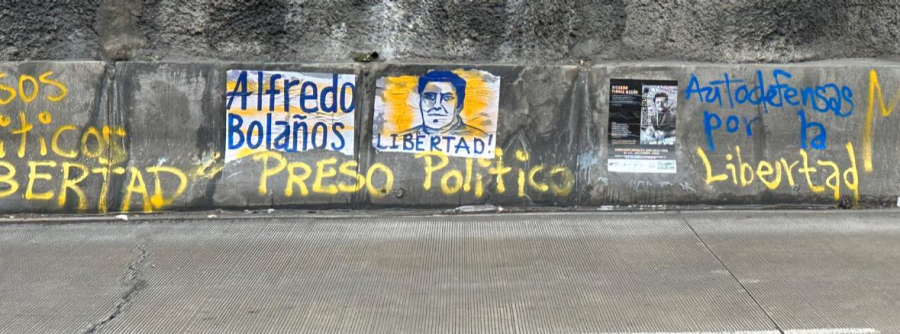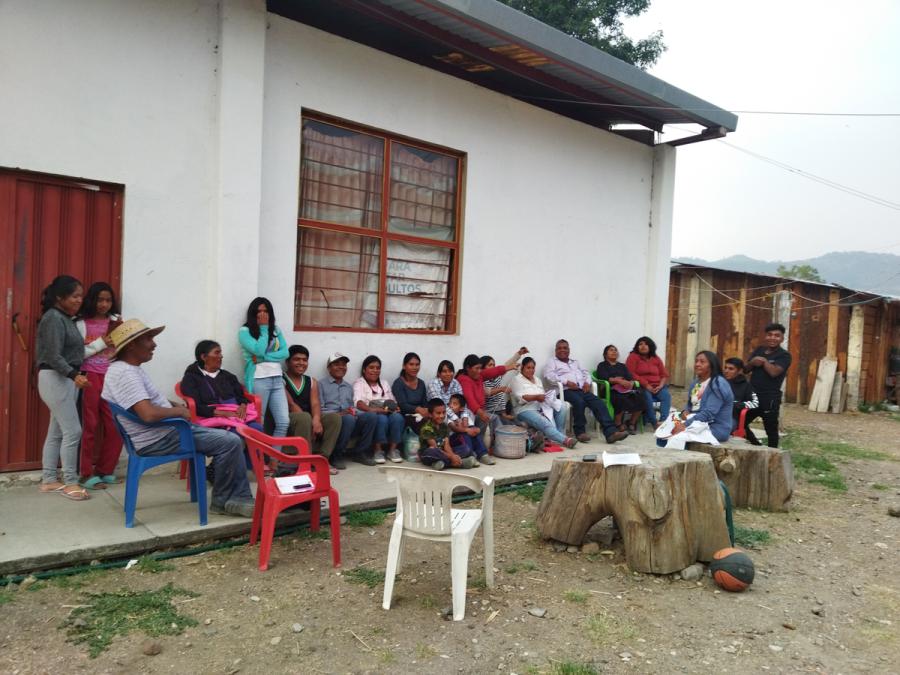On 23 and 24 July, Beatriz Manz and Jason Clay visited the refugee camps at China, Hecelchakan and Canasayab in Campeche. At that time some 9,000 refugees had been moved to Campeche from Chiapas. Two weeks later, more than 12,000 had been moved. China and Hecelchakan are temporary camps where refugees are held until housing has been built in the permanent camps. At the time of our visit, Canasayab was the only permanent camp in Campeche that had been opened. COMAR officials said that another was being built at Pich, near the Mayan ruins at Edzna, and that two more would be opened in Quintana Roo as the number of relocated refugees increased. They also said that 400 refugees had been settled in the state of Tabasco. The following report was written by Jason Clay.
China
This camp is located on the railroad line two kilometers from the town of China and just over 20 kilometers from downtown Campeche. The camp consists of two large concrete warehouses that, combined, can house a maximum of 2000 refugees. A covered cooking area and a rock covered piece of land some 50 by 250 meters forms the remainder of the camp.
The most striking things about the camp are the lack of privacy and the prevailing sense of boredom. Approaching the camp from the paved road one sees more than a hundred men, women and children bathing in the open, next to each other, out of small containers of water. There is no free flowing water in the camp although there seemed to be plenty of water in the storage tank that receives some 6 truck loads of water each day. Camp residents complain that there is no water where they can easily bath or wash their clothes. There are no trees to give privacy.
In the warehouses, people use every inch of the floor space. The old, sick or pregnant women are supposed to have cots, but there are not enough. The rest of the people sleep directly on the concrete unless they have their own blankets. Families have created tiny occupied areas on the floor that are distinguished from those of other families by the possessions that each was allowed to bring. Families from the same village in Guatemala or at least the same camp in Chiapas have remained close to each other in the warehouses, in effect constructing villages without walls. While crowded, the warehouses are clean, well lit and cool.
The prevailing mood of the camp is lethargy and boredom. Boredom because there is nothing for anyone to do and because they are not allowed to walk outside of the camp area. No one is organizing games for the children; everyone is waiting to see what will happen. When outsiders come to the camp, 50-100 people immediately circle around to hear what they have to say. They are also interested in official answers to such questions as, will the refugees be allowed to plant crops or work as laborers in Campeche.
The lethargy of the refugee population is, in part, related to the boredom, but, more importantly, is a function of severely restricted food rations. Refugees are given 2.5 to 3 ounces of rice and beans each three times per day. In addition, each refugee receives two tortillas with each meal. In Chiapas, Mayan Indians say that a meal with less than a half a dozen tortillas is a dog's meal. As of late July, there was no supplemental feeding for malnourished infants at this camp.
The first refugees arrived from Chiapas on June 30. As of 23 July, 1948 refugees were in the camp and 5000 had been processed through it. The first refugees to come to China were from Las Delicias and Chupadero. By late July they had already been relocated permanently in Canasayab. The second group of refugees to come to China were from the Lacandon forest area of Chiapas. They came from Chajul, Ixcan, Puerto Rico, Playon de la Gloria and Pico de Oro. Many of these refugees were still in China in late July.
The refugees arrived in China after travelling by canoe to Boca de Lacantun, then by bus to Palenque and finally by train to China. The trip from Boca de Lacantun to Palenque took about 5 hours. The trip from Palenque to China took 8-10 hours. The refugees were given nothing to eat or drink during either of the trips.
The first arrivals at China were there for as much as four weeks before they were moved to the permanent camp at Canasayab. COMAR insists that refugees are now only in the camp for a week to ten days.
Most of the refugees interviewed indicated that they would have preferred to stay in Chiapas. They were accustomed to the area; they knew how to live there. Officials reportedly told them that they would have to "live with the consequences" if they remained in Chiapas. The refugees accepted the mandate of the government, saying, "We'll see what happens to those who refused to be moved."
COMAR officials insist that the refugees' health is no worse than it was in Chiapas. A number of children are malnourished, but officials quickly point out that the proportion is probably smaller than when the group arrived in Mexico from Guatemala. Officials admitted that a number of refugees were suffering from fatigue, dizziness, diarrhea and vomiting when they arrived at China. They attributed the condition to the change in food (rice substituted for corn as a staple in the diet) and climate. Officials also pointed out that few of the refugees had ever travelled so far. Refugees responded, however, that they were not given food or water en route to Campeche and that when they were in holding camps along the way, food was only provided sporadically and at odd hours. One group, for example, arrived at Palenque in late afternoon, but were not given food until 11 a.m. the next day. COMAR would not even allow a resident of Palenque to bring cooked food he wanted to donate for the refugees.
Hecelchakan
The second temporary camp in Campeche is on the northern outskirts of Hecelchakan which lies on the main road between Merida and Campeche near the state border. The camp is nearly identical to the one in China. Two large warehouses are used to house the refugees. Again, the movements of the refugees are limited to the immediate environs of the warehouses. Boundaries are delimited by a road and the railroad. Here, too, there is little privacy and nothing for the refugees to do.
After only 20 minutes in this camp, we are asked to leave by the head of COMAR in Campeche. There were about 1500 refugees in the camp, but more than 350 arrived by train that day in Campeche where they were transferred to trucks and transported in groups of about 40 to Hecelchakan.
Canasayab (near Felipe Carrillo Puerto)
This "permanent" camp for the refugees is located some 400 kilometers to the east of the main road between Villahermosa and Campeche. The camp itself is in the middle of a fairly dense forested area of government land. The trail into the area, recently widened with bulldozers, has been gravelled. The camp itself is being carved out of the forest. The trees that are being cut (some more than a foot in diameter) are either used for firewood or for building houses.
The camp is laid out on a grid that ignores the local, hilly topography and is divided into three "models" that will contain 3000 people and 600 houses each. By late July, one model was full and a second was half full. At that point, the major bottleneck to the relocation of refugees appeared to be house construction. Mexicans are employed to lay out the streets of the three models and to erect the house frames. Refugees are then expected to enclose the homes. The only standard building procedures are for roofs. The government provides corrugated tar paper for that purpose.
The camp is certainly an improvement over the temporary accommodations at China and Hecelchakan. Refugees have space to move about. The children can play in the woods. One hears guitar music coming from many of the houses. Each family has the privacy of their own home. The houses of people from the same village are side by side. Firewood is certainly not a problem. While there appears to be an abundance of water, it comes from a single well. If the motor breaks, all camp residents will be out of water. There are no free flowing streams in the area. A 50,000 liter storage tank was being constructed on the highest point in the camp and a water system was being laid throughout the first of the three models. In the meantime, people use water that is pumped into a tank truck which is used as the camp's storage tank.
Food seemed plentiful in this camp. Each family was given one kilogram of rice and beans per day and one kilogram of corn flour per person per day. There was little diversity, however. The malnourished children were receiving supplemental feeding. From questioning a number of camp residents, it seemed that about every family with children had a child receiving the food supplements.
In late July it was unclear whether the refugees would be allowed to work in Campeche. By August, COMAR officials insisted that they would be allowed to COMAR says that refugees will be allowed to plant corn in Canasayab. Indeed, there is corn growing in a recently cleared field near the camp. How much land would 9000 people have to clear to plant sufficient corn to become self-sufficient? What are the ecological consequences of having a town of 9,000 (rather than dispersed villages of a few hundred, the traditional Mayan pattern) begin intensive slash and burn agriculture? These are just a few of the future questions that are sure to arise in the permanent refugee camps in Campeche.
Article copyright Cultural Survival, Inc.



